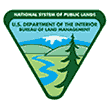|
Sonoran Desert National Monument Arizona |
 |
 BLM photo | |
The saguaro cactus is the iconic symbol of the Sonoran Desert and the monument is a place to see extensive forests of the classic cactus. But the monument has more to offer, including distinctive mountains rising from the desert floor. It has three distinct mountain ranges: the Maricopa, Sand Tank, and Table Top Mountains, as well as the Booth and White Hills, all separated by wide valleys. You can hike or ride horseback almost everywhere in the monument. Four designated trails in three congressionally designated wilderness areas total 26 miles. Many miles of roads are available for mountain biking and motorized vehicle tours. The monument has significant archaeological and historic sites, and remnants of several important historic trails, including the Juan Bautista de Anza National Historic Trail. This congressionally designated trail parallels the Butterfield Overland Stage Route, the Mormon Battalion Trail, and the Gila Trail.
The southern part of the monument is a corridor for drug and human smugglers. Be alert for illegal activities and law enforcement operations.
The monument offers many opportunities to explore and discover the secrets of the Sonoran Desert and includes three wilderness areas: the North Maricopa Mountains Wilderness, the South Maricopa Mountains Wilderness, and the Table Top Wilderness. These wilderness areas offer excellent opportunities for solitude and unconfined recreation. The North Maricopa Mountains Wilderness has two hiking and equestrian trails, the 9-mile Margie’s Cove Trail and the 6-mile Brittlebush Trail. The Table Top Wilderness also has two hiking and equestrian trails, the 7-mile Lava Flow Trail and the 3-mile Table Top Trail. A section of the Juan Bautista de Anza National Historic Trail crosses the national monument. A four-wheel-drive route follows the trail corridor for approximately 10 miles through the national monument.
Source: BLM Website (March 2023)
|
Establishment Sonoran Desert National Monument — January 17, 2001 |
For More Information Please Visit The  OFFICIAL BLM WEBSITE |
Documents
Annual Manager's Report: 2021, Sonoran Desert National Monument (Katie White Bull, Amber Redger and Erich Schow, 2021)
Annual Manager's Report: 2022, Sonoran Desert National Monument (Katie White Bull, J. Chris Wonderly, Kendra Loubere, Damon Haan, Alexandra Hawes and Jason Marsoobian, 2022)
Annual Manager's Report: 2023, Sonoran Desert National Monument (matt Drahnak, 2023)
A Summary of Economic Performance in the Surrounding Communities: Sonoran Desert National Monument (Headwaters Economics, Spring 2017)
Bibliography (undated)
Biological Resources of the Sonoran Desert National Monument Working Draft (Drylands Institute, June 2001)
Livestock Grazing, Final Resource Management Plan Amendment/Environmental Assessment, Sonoran Desert National Monument (October 2024)
Manager's Annual Report, FY2011, Sonoran Desert National Monument (Rich Hanson, 2011)
Manager's Annual Report, FY2014, Sonoran Desert National Monument (David Scarbrough, 2014)
Map: Sonoran Desert National Monument (BLM, 2015)
Map: Sonoran Desert National Monument (BLM, 2020)
Natural Communities of the Sonoran Desert National Monument and Sand Tank Mountains (Peter H. Morrison and Susan D. Snetsinger, Pacific Biodiversity Institute, March 2003)
Proclamation 7397—Establishment of the Sonoran Desert National Monument (William J. Clinton, January 17, 2001)
Record of Decision and Resource Management Plan (September 2012)
Science Plan, Sonoran Desert National Monument (BLM, November 14, 2019)
Travel Map, Sonoran Desert National Monument (2016)
sonoran-desert/index.htm
Last Updated: 01-Jan-2025